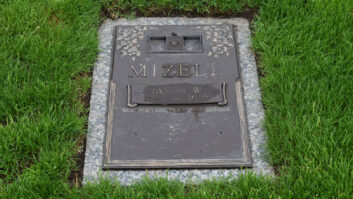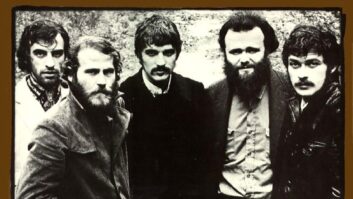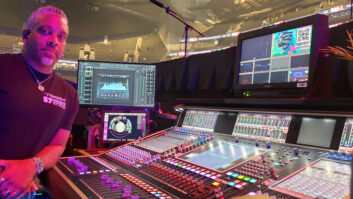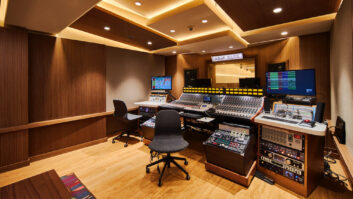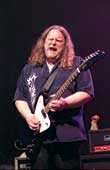
So you think you’re busy? How’d you like to be in Warren Haynes’ shoes? The prodigiously talented guitarist/singer/songwriter is having quite a year, juggling commitments to three different jam bands: the Dead, where he and Jimmy Herring are sharing the guitar duties once handled by Jerry Garcia (and Haynes is singing many of Garcia’s songs); the Allman Brothers, Haynes’ on-and-off second home since he helped revitalize the band 15 years ago; and Gov’t Mule, the long-running power trio — now expanded to a quartet — that is Haynes’ principal vehicle for his material.
I caught up with the affable North Carolinian a day after his July Allmans tour ended, which was the day before the second leg of the Dead’s summer tour. Down the line, he was scheduled to fly directly from the Dead’s last show in Atlanta to the first show of the next part of the Allmans’ tour in New Hampshire. September would find him on the road with Gov’t Mule, promoting the album he made in his “spare” time, Déjà Voodoo.
“It’s been crazy,” he says with a laugh from a hotel room in St. Louis. “I’m bouncing from one to the other to the other. But if I were going to be this busy, it’s better to do it with multiple projects rather than just one; it’s easier to get burned out on a single project.”
Haynes has been hovering in the Grateful Dead’s universe for the past few years; he and Herring were members of the Dead’s bassist Phil Lesh’s exceptional quintet, Phil Lesh & Friends. But this year marked the first time he has toured with surviving Dead members Lesh, guitarist Bob Weir and drummers Mickey Hart and Bill Kreutzmann. “It feels totally different than Phil & Friends,” he offers. “I was prepared for a lot of the material, having played in Phil and Friends, but the approach here is totally different. Bobby’s such a unique guitarist and, of course, having the two drummers changes everything.
“As far as my own playing goes, I try to take a different approach in each band: use different guitars, different speaker cabinets and different amps. With the Dead, I find that the Les Paul takes up too much space — it’s got a lot of midrange — so I end up playing a [Gibson] SG or a 335, or an Epiphone Sheridan. I have this new Corrina Les Paul with an ebony fingerboard that’s much brighter than a regular Les Paul. Then, effects wise, with the Allman Brothers, I don’t really use any. In the Dead and Gov’t Mule, I use different effects, just trying to give each a distinct personality.”
Though Haynes says that working with the Dead is “an amazing opportunity” and that the Allmans “have been like family” to him, “Gov’t Mule is something I plan on doing for many, many years to come. Gov’t Mule is where I can create anything I want to and there are no parameters and no pressure; it’s the vehicle that’s necessary for me to do what I need to do.”
The current Gov’t Mule lineup, from left: guitarist/vocalist Warren Haynes, bassist Andy Hess, keyboardist Danny Louis and drummer Matt Abts
Photo: Danny Clinch
Déjà Voodoo marks Gov’t Mule’s first “regular” studio outing since the death of original Mule bassist Allen Woody four years ago. In the years after Woody’s demise, Haynes and drummer Matt Abts were in search mode, retooling the Mule using a slew of great bass players — including Lesh, Jack Bruce, Jack Casady, the late John Entwistle, Bootsy Collins, Flea, Tony Levin, Victor Wooten, Jason Newsted and a host of others — on a pair of fine studio CDs, The Deep End, Vol. I and II, and a live DVD/CD.
During that period, Gov’t Mule also brought in a number of fine keyboardists and other support players, but eventually settled on a new permanent lineup: Haynes, Abts, bassist Andy Hess and keyboardist Danny Louis. The new Mule is every bit as heavy as the old one: Déjà Voodoo is loaded with long, blues-soaked tunes that give Haynes plenty of space to stretch out on guitar and unleash his potent growling vocals. These guys can definitely rock hard, but Haynes actually seems to prefer simmering ballads and sprawling mid-tempo numbers.
The Mule disc was cut at one of Haynes’ favorite studios, Water Music in Hoboken, N.J., aided by his longtime co-producer and engineer, Michael Barbiero. “I’ve done a lot of projects there,” Haynes says. “The third Mule record was done partially there; we did the last Allmans album there and I produced the Bottle Rockets there.
“Michael [Barbiero] really loves that studio,” he continues. “It’s got an old Neve 8078 and one of the better ones — it’s in great shape and it sounds amazing. It’s got a really big control room and a big cutting room that can be sectioned off any way you want. It’s very ambient, but you can structure it so there’s more isolation if that’s what you’re after. In the past, to get the big rock drum sounds, we’ve always set the drums out in the middle of the room and there’s a certain place the room mics catch the most ambience. But Matt [Abts] and Michael decided they wanted to go for a little different sound on this record, so we moved the drums to a different place closer to the control room in a less ambient spot. We went for a little tighter sound.
“We set up all the keyboard stuff in a huge iso room — two Leslies, an amp for the clavinet, an amp for the Wurlitzer — and it was even big enough to put ambient mics in there.
“I had my guitar rig set up in another fairly big [iso] room. We’re all actually out in the main room together, but our stuff is in iso rooms. I’m standing near mine, with the [iso room] door partially open so I can feel some of the pressure [from the speaker cabinets] and I can hear it bleeding, but it’s not overpowering everything in the main room.” Haynes says that basic tracks were cut live; finished vocals and overdubs were added later, though the disc still manages to have a live-in-the-studio feel.
For miking the cabinets, Haynes says he’ll “usually just use two, but occasionally three mics. On the 4-by-12s, I’ll have a [Sennheiser] 421 and a [Shure] 57 on each. Then on the Zeta, just a 57. We also started doing something new on this album. We took this sheet of plywood and put it on an adjacent wall in the room and we put a 57 facing the plywood, away from the speaker. That’s for the Zeta more than anything — you mike the area where the Zeta sound is hitting the plywood and it gives it a nice quality.
“I have a Bradshaw switching system where I can use up to three amps at a time and blend them together, and I can have my effects going through them or not, depending on how they’re programmed. So it makes switching and looking for sounds a lot cooler. When we’re setting up from song to song, we’ll try something and I’ll check it with Michael to see if a combination is better than some of the parts. For the most part, they’re all going to different tracks; occasionally, we might commit and blend two onto one track.”
For his vocals, Haynes used an AKG C1000S condenser mic. “I’d been using an SM7, but I got a little tired of it, which is something that happens,” he says. “Sometimes, you just want to try something new. So Michael and I went through a bunch of options and agreed that the AKG sounded the best with my voice.”
Déjà Voodoo was recorded to analog tape (“I still prefer the sound of hitting tape first,” Haynes says) and then transferred to Pro Tools for editing. It was mixed on an SSL at Soundtrack in New York City. “Michael loves to mix there,” Haynes says. “The new SSLs have a lot of bottom end, and he’s a bottom-end freak. The early Mule records were all mixed on Neves.
“Making records is something I really enjoy — playing on records, producing them. I’m not one of those guys who thinks that playing live is the whole thing…though, obviously, I enjoy that, too.” Indeed, playing concerts — not album sales — has been Haynes’ bread-and-butter throughout his career, which is how he’s earned his rep as an infinitely creative and indestructible road warrior. And speaking of which, tonight it’s the Dead, so it’s time to shift gears, quit the promo talk for the Mule album and get ready to knock ’em out in St. Louis. I conclude by asking Haynes if he ever mistakenly plays Allmans’ licks in Dead songs and Dead licks in Allmans’ songs.
“Well, it’s never a mistake,” he says with a chuckle. “I do it on purpose. At [Dead] rehearsal last night, we were playing [Garcia’s] ‘Foolish Heart’ and all of a sudden, Jimmy [Herring] and I both arrived at [The Allmans’] ‘Blue Sky’ at the same moment. It was perfect — I love it!”


